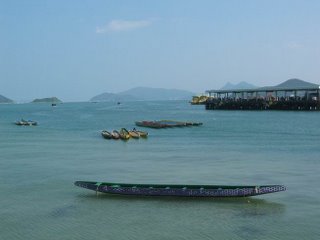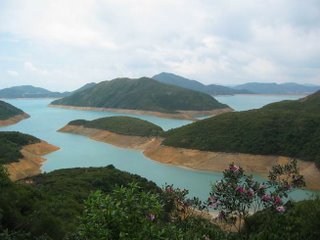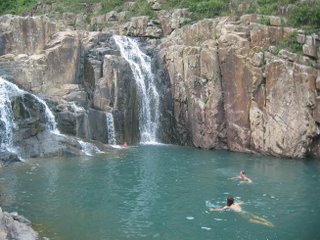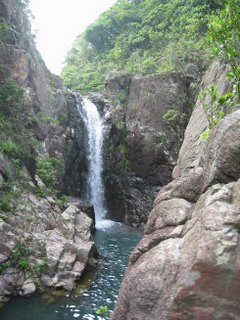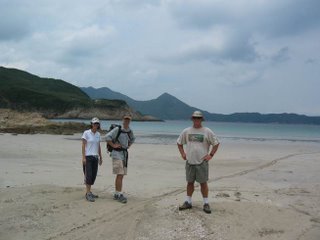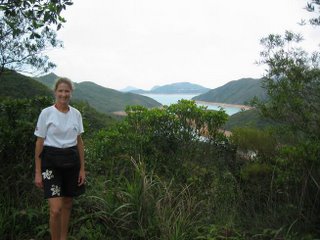Bright Lights, Big City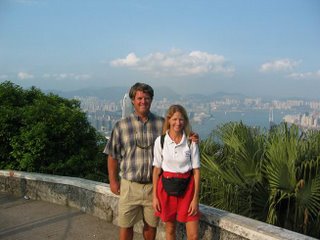 And now for something completely different . . . Bright Lights, Big City!
And now for something completely different . . . Bright Lights, Big City!After being in such remote places for so long, we’re pretty keen to see a place that everyone has heard of, that has all the modern conveniences, and offers all the excitement anyone could ever hope for. We’ve found all that and more. Hong Kong is a place focused on the present and is obsessed with making progress. The city presents quite a contrast to the sleepy historical backwaters and primitive cultures where we’ve been, in which the past is revered and change is approached with reservation.
I came here on business years ago and was so impressed that I always wanted to return. Little did I suspect then that I’d be sailing my own sailboat to such an amazing metropolis. Downtown Hong Kong is perched on an island of the same name but also includes Kowloon on the opposite (mainland) side of Victoria Harbor, one of the busiest waterways in the world. In addition to container ships, ferries, tugs/barges, tour boats and pleasure vessels ply the harbor, making it a very exciting yet stressful place to sail.

Hong Kong proper is a city of high population density, with tall cell block style apartment complexes perched on the hills, housing millions of people in a tiny area.

Every scrap of the city has a function and tiny vender stalls are crammed into the tiniest spots in most parts of the city.
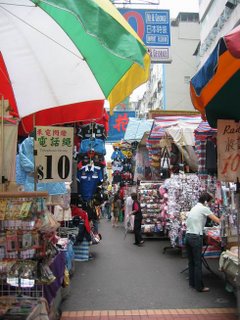
Steep narrow streets and alleys make a rabbit warren of places to explore.
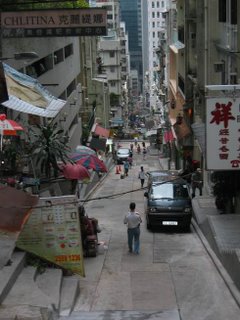
Yet the concrete jungle of downtown quickly turns to nature, as much of the surrounding area is reserved for park land. The area is surrounded by over 230 islands, most of which remain uninhabited and natural. We’re keen to sail to some of the outlying islands for an occasional rest from the bustle of the city. Numerous nature hikes are only a short distance from the bustle of the city even on Hong Kong Island and in Kowloon.

The hilly topography makes the city so intriguing and scenic. Glass skyscrapers line the downtown waterfront and reach up the hills, making for a stunning view. Building designs celebrate unusual architecture making for an interesting skyline. Countless buildings offer gorgeous views of the city.

At night, the city lights up with neon signs. Each evening at 8pm, the largest symphonic light show in the world brings the colorful neon and lasers of more than 30 buildings into harmony with music played over the radio. Buildings are changing color; lights are moving around in patterns, flashing on and off; and search lights and lasers are shooting around, making for a fascinating and spectacular display of electricity and waste of fossil fuels.

We experience sensory overload frequently. The pace of the city can be mind boggling. Signs compete for our attention. Shop windows advertise bargains. The Chinese writing everywhere adds to the visual noise. Vendors try to entice us to buy. Construction is perpetual somewhere in the city yet projects are quickly completed. Some areas where bamboo scaffolding reaches up the side of a building look like major projects yet we return the next day to find the area transformed in a mere 24 hours. Reclamation of land has changed the face of the city many times over. We’ve heard of countless waterfront views blocked by a new building that has risen up on landfill that formerly was part of the harbor. The distance between Hong Kong Island and Kowloon is shrinking all the time as once submerged areas are turned into high rises. Strong odors, many unpleasant, assault us: exhaust fumes, rotting seafood, meat or produce, dried medicines and snacks offered in bulk. And mostly we have been overwhelmed by the sheer magnitude of people at the peek travel times of the day. Hordes of people push past us in a rush to get where they are going. Rarely does a minute pass by without seeing someone talking on a cell phone.
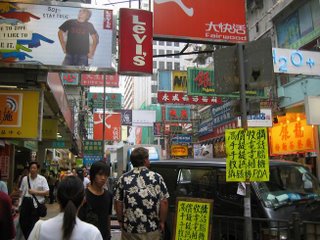
Public transportation is extremely efficient and sophisticated and everyone uses it. A magnetic debit card of sorts works for all types of non-pedestrian transportation and more. What we call a subway, called the MTR here, moves thousands of people per minute to stops dotting the city. The word subway here is used to describe under road tunnels/passageways and should not be confused with the MTR transportation network. We almost got off a bus, thinking we had reached an MTR station, when in fact what we saw was merely a sign for an under road passageway. Huge transfer stations bring various MTR lines together that run in multiple directions encompassing the entire city.
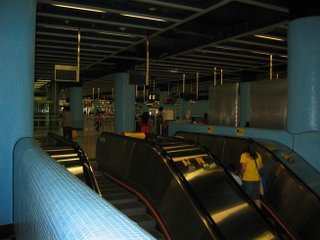
A pleasant voice announces the next station in 3 languages. The upcoming station is also highlighted by a light on a map of the MTR network above the doorway of each train. A proper English accent reminds us to “Mind the Gap” as we exit the train. Double decker buses and trams wind the narrow steep streets. The buses are very nice and clean, with handicapped facilities and flat screens displaying ads or public service announcements. (The buses don’t rattle like they do in Seattle.) Taxis are everywhere. Ferries offer transport to outlying islands as well as offer an incredibly cheap and scenic ride across Victoria Harbor.

The longest escalator in the world connects overpasses and walkways to move large numbers of people up the hill to the apartment complexes perched above the downtown area. Cross signals are made audible and enable diagonal crossing so that large numbers of people can cross at once. With the incredible volume of people that are traveling, this efficiency is essential. Police quickly hassle double parkers to prevent traffic jams.
In keeping with the British style, vehicles drive on the left. During the course of our travels, we have gotten used to this after spending so much time in areas influenced by Australia and New Zealand in the South Pacific. When we returned to US areas, it took us a while to readjust to the American way. Just as we have made the adjustment back, it’s time to reverse again to the opposite system.

We have to make sure we look both ways before crossing. We have found ourselves accidentally standing at a bus stop on the wrong side of the road for the direction we want to go. While people drive on the left, as a pedestrian it seems like anything goes on stairwells and passageways, which could be a result of Hong Kong being a gathering of people from all over the world with various systems.
The upside of a large metropolis is the variety of people and cultures it attracts. The people watching is compelling.We hear a wide variety of languages spoken as we explore the city. And, being such an international city, the variety of fine food available is astounding. We sampled Nepalese food, and the day after we enjoyed a Spanish meal. Italian delis and French bakeries tempt us constantly. Italian, Indian, Thai and Vietnamese restaurants are everywhere. Grocery stores offer countless delicacies we haven’t seen in years and countless things to try, if only we could figure out what they were! The intersection of the staid British style and the mildly chaotic Chinese is part of what makes Hong Kong such an interesting place. And that stark cultural contrast, makes New York City seem dull in comparison to Hong Kong.

We are relieved to return to the quiet of our boat after a day in the fast paced city. After a day of wandering the city, we can feel the grime on our skin and are keen for a shower. The fumes from passing motorists on the streets or even in the bay from passing boats are particularly noticeable after experiencing the clear air of the ocean. Despite hills and skyscrapers offering stunning views of the city, frequently the skyline is muted in haze. After our arrival, it was at least a week before we saw the tops of the hills around the bay where we are moored. We initially thought this haze in the air was fog, but started to realize that the haze was the result of pollution. When the wind blows from the north, the pollution from the factories on the Chinese mainland blows down onto Hong Kong. Of these factories, more than 70,000 of them are owned by Hong Kong people! We have noticed a distinct difference in air quality based on the wind direction. A southerly wind clears the skies, while a northerly brings on the haze. We have had days when visibility is reduced to ¼ mile and the skyscrapers were not even visible from across Victoria Harbor! Kind of brings to mind the coal dust of the industrial revolution in London.

The pollution in the air means that when it rains soot coats all surfaces and the boat needs to be washed frequently. We were shocked to discover one morning after a heavy rain that we had a distinct black scum line inside our clean dinghy! Not sure how our white dodger and awning will survive the onslaught!

